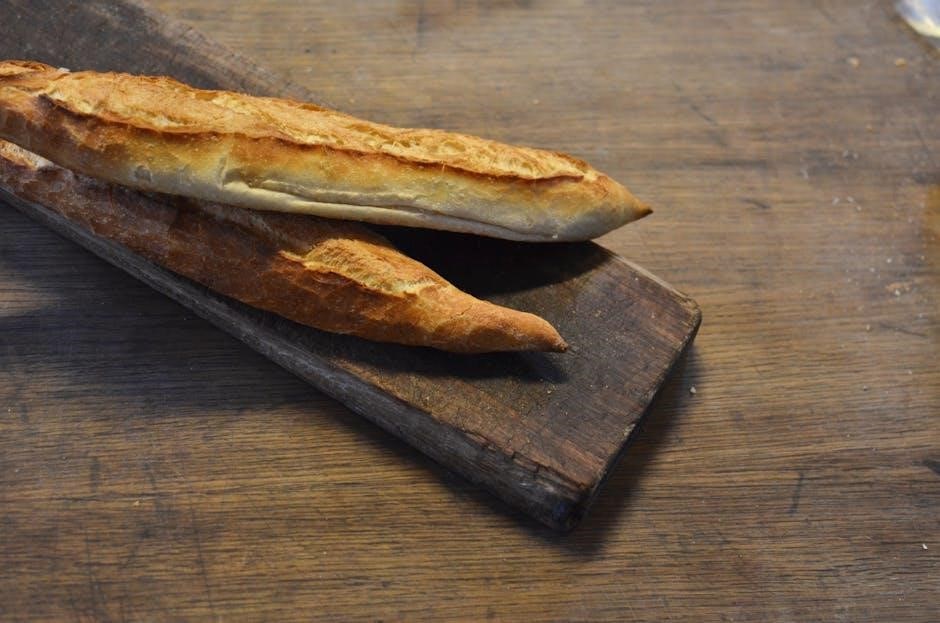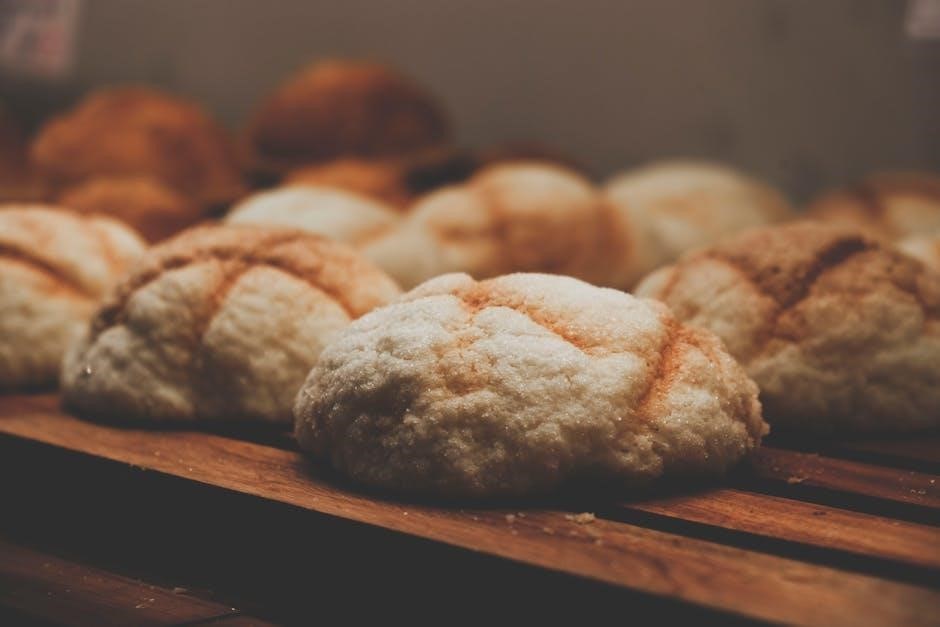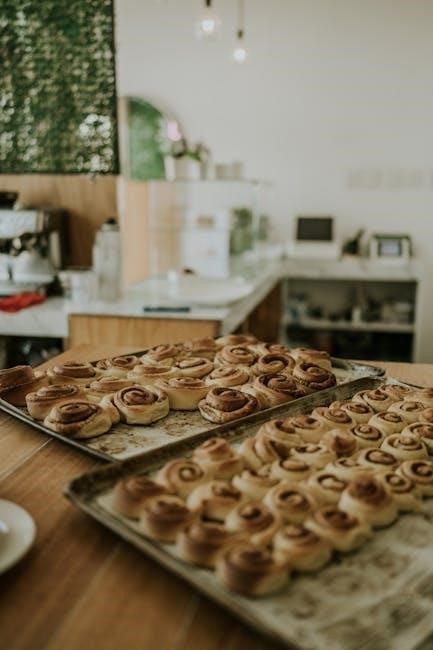A yeast-free diet focuses on eliminating foods that contain yeast or mold, reducing sugar intake, and making informed dietary choices to support health and digestion.
Understanding the Importance of a Yeast-Free Diet
A yeast-free diet is essential for managing conditions like candida overgrowth and digestive imbalances. Yeast-containing foods and high-sugar intake can disrupt gut health, leading to symptoms like bloating and fatigue. By eliminating yeast and mold, individuals can reduce inflammation and promote a balanced microbiome. This diet is particularly beneficial for those with sensitivities or allergies, helping to alleviate skin issues and improve energy levels. It also encourages healthier eating habits, focusing on whole, unprocessed foods. Resources like yeast-free food list PDFs provide guidance, making it easier to navigate dietary changes. Understanding the importance of this diet helps individuals make informed choices, leading to long-term health benefits and improved well-being.
Benefits of Adopting a Yeast-Free Lifestyle
Adopting a yeast-free lifestyle offers numerous health benefits, particularly for those with yeast sensitivities or candida overgrowth. It helps reduce inflammation, improve digestion, and alleviate symptoms like bloating and fatigue. By eliminating yeast-containing foods, individuals can promote a balanced gut microbiome, enhancing overall well-being. This diet also encourages healthier eating habits, focusing on whole, unprocessed foods, which can lead to weight management and increased energy levels. Additionally, it supports skin health, reducing issues like acne and rashes. Resources like yeast-free food list PDFs make it easier to transition, ensuring individuals stay on track. Overall, a yeast-free lifestyle is a proactive approach to improving health and preventing chronic conditions, offering long-term benefits for those who commit to it.
What Foods to Avoid on a Yeast-Free Diet
Avoid foods containing yeast or mold, such as baked goods, beer, and mushrooms, as well as high-carbohydrate and sugary foods that promote yeast growth.
Foods Containing Yeast or Mold
Identifying foods with yeast or mold is crucial for a yeast-free diet. Common culprits include breads, pastries, and baked goods, as they often contain baker’s yeast. Beer, wine, and fermented beverages like kombucha and vinegar should also be avoided due to their yeast content. Mold-containing foods, such as mushrooms, blue cheeses, and fermented dairy products, must be eliminated. Processed foods like crackers, pretzels, and commercial snacks frequently contain hidden yeast. Additionally, foods like soy sauce, miso, and some condiments may harbor yeast or mold. Always read labels carefully, as yeast can be listed under various names. Avoiding these foods helps reduce yeast intake and supports overall health goals.
High-Carbohydrate and Sugary Foods to Limit
High-carbohydrate and sugary foods can fuel yeast growth, making them a focus for limitation on a yeast-free diet. Sugary snacks like cakes, muffins, and pastries should be avoided due to their high sugar content. Refined grains, such as white bread and pasta, are also problematic. Fruit juices and dried fruits, while natural, are high in sugar and should be consumed in moderation. Candies, chocolates, and sweetened beverages are additional sources of excess sugar. Even starchy vegetables like potatoes and corn should be limited. Reducing these foods helps starve yeast of its primary energy source, supporting a balanced digestive environment and overall well-being. Opting for whole, nutrient-dense foods instead is highly recommended.

Yeast-Free Food List: What You Can Eat
A yeast-free diet includes fresh meats, poultry, fish, non-starchy vegetables, and whole grains. Focus on unprocessed foods, avoiding hidden yeast sources like fermented items and high-sugar snacks.
Meat, Poultry, and Fish Options
Fresh, unprocessed meats, poultry, and fish are ideal for a yeast-free diet. Choose grilled, baked, or steamed options without added sauces or marinades. Opt for lean meats like chicken, turkey, or beef, and avoid processed varieties like sausages or deli meats, which may contain hidden yeast. Fish such as salmon, cod, and tilapia are excellent choices. Ensure all meats are free from stuffing or gravy, as these often contain yeast. Avoid breaded or battered foods, as they may include yeast-based ingredients. Always check labels for added yeast or preservatives, especially in packaged or frozen items. Plain, unseasoned meats are the safest bet to maintain a yeast-free regimen.
Vegetables, Fruits, and Whole Grains
Fresh vegetables are a cornerstone of a yeast-free diet, with options like leafy greens, broccoli, spinach, and bell peppers. Most vegetables are naturally yeast-free, but avoid fermented varieties like sauerkraut or kimchi. Fruits should be chosen wisely; opt for low-sugar options like berries, citrus, and apples, while limiting tropical fruits like mangoes and bananas. Whole grains like brown rice, quinoa, and oats are permissible, provided they are unprocessed and free of yeast additives. Avoid grains with added yeasts, such as beer-battered or breaded products. Always check labels for hidden yeast in packaged grains. Incorporating a variety of colorful vegetables and moderate portions of fruits ensures a balanced and nutrient-rich diet while adhering to yeast-free guidelines.

Grocery Shopping Guide for a Yeast-Free Diet
When shopping, focus on fresh, unprocessed foods. Always read labels to avoid hidden yeast in ingredients. Choose yeast-free alternatives and opt for whole, nutrient-rich options.

Reading Labels and Avoiding Hidden Yeast
Reading food labels is crucial on a yeast-free diet, as yeast can hide in unexpected products. Look for ingredients like yeast extract, brewer’s yeast, or active dry yeast. Avoid foods with mold, such as aged cheeses, fermented beverages, and vinegars. Even some condiments and sauces may contain yeast. Opt for products labeled as “yeast-free” or “no added yeast.” Be cautious with processed foods, as they often include yeast-based additives. When in doubt, choose fresh, whole ingredients like meats, vegetables, and whole grains. Always check for certifications or contact manufacturers if unsure. This careful approach ensures compliance with your dietary goals and helps maintain a balanced, yeast-free lifestyle.

Meal Plans and Snack Ideas
Discover delicious yeast-free recipes for breakfast, lunch, and dinner, along with healthy snack options to keep you satisfied and on track with your dietary goals.
Breakfast, Lunch, and Dinner Recipes
Start your day with yeast-free breakfast options like scrambled eggs with spinach, avocado toast on yeast-free bread, or a smoothie made with fresh berries and almond milk; For lunch, try grilled chicken salads with mixed greens, cucumbers, and olive oil dressing, or a hearty vegetable soup. Dinner ideas include baked salmon with steamed broccoli, stuffed bell peppers with quinoa and ground turkey, or zucchini noodles with pesto sauce. Snacks can be fresh veggies like carrots and celery with hummus or a handful of nuts like almonds and walnuts. These recipes are easy to prepare and align with yeast-free dietary guidelines. Downloadable PDF guides offer more detailed meal plans and creative ideas to keep your meals exciting and varied.
Additional Resources and Downloads
Access free PDF guides and printable lists for a yeast-free diet, including grocery shopping tips and meal plans to simplify your transition to a yeast-free lifestyle.
Free PDF Guides and Printable Lists
Download comprehensive PDF guides and printable lists tailored for a yeast-free diet. These resources include detailed food lists, meal plans, and shopping tips to help you navigate grocery aisles confidently. Many guides categorize foods into “allowed” and “avoid” sections, making it easier to plan meals and snacks. Some PDFs also offer recipes and substitution ideas for common yeast-containing foods like bread and baked goods. Printable lists are perfect for posting on your fridge, ensuring you stay on track with your dietary goals; These resources are often updated, so check back regularly for new additions and tips to support your yeast-free journey.
A yeast-free diet promotes healthier eating by eliminating harmful yeasts and sugars. With proper planning and resources, it can lead to improved digestion and overall well-being long-term.
Final Tips for Maintaining a Yeast-Free Diet
To maintain a yeast-free diet long-term, plan meals in advance and keep a grocery list handy. Always read food labels carefully to avoid hidden yeast or mold. Opt for fresh, whole foods like lean meats, vegetables, and whole grains, and limit processed items. Stay hydrated and incorporate probiotic-rich foods like plain yogurt to support gut health. Avoid sugary snacks and opt for natural sweeteners like berries instead. When dining out, choose grilled or steamed options without sauces. Finally, consult downloadable PDF guides or apps for quick reference and stay consistent to reap the benefits of a yeast-free lifestyle.